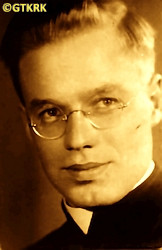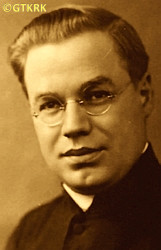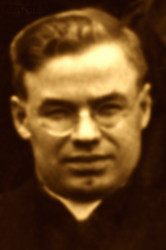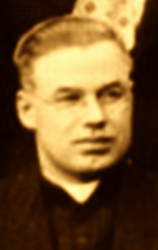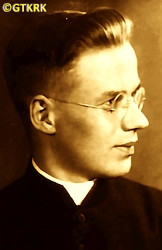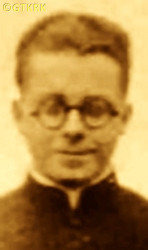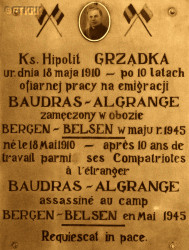Roman Catholic
St Sigismund parish
05-507 Słomczyn
85 Wiślana Str.
Konstancin deanery
Warsaw archdiocese, Poland
full list:
displayClick to display full list

searchClick to search full list by categories
wyświetlKliknij by wyświetlić pełną listę po polsku

szukajKliknij by przeszukać listę wg kategorii po polsku

Martyrology of the clergy — Poland
XX century (1914 – 1989)
personal data
surname
GRZĄDKA
forename(s)
Hippolytus (pl. Hipolit)
function
diocesan priest
creed
Latin (Roman Catholic) Church RCmore on
en.wikipedia.org
[access: 2014.09.21]
diocese / province
Polish Catholic Mission in France
Gniezno and Poznań archdiocese (aeque principaliter)more on
www.archpoznan.pl
[access: 2012.11.23]
date and place
of death
03.03.1945

KL Bergen‐Belsenconcentration camp
today: n. Bergen, Celle dist., Lower Saxony state, Germany
more on
en.wikipedia.org
[access: 2022.01.09]
alt. dates and places
of death
15.03.1945, 05.1945
details of death
In 08.1941, during World War II, which began in 09.1939 with the German and Russian invasion of Poland, after German invasion of France in 05‐06.1940 and start of German occupation, escaped to the south of France, to territories that were initially not directly occupied by Germany and functioned under the colloquial name Fr. La France de Vichy (Eng. Vichy France), officially Fr. L'État français (Eng. The French State), although de facto under German control.
Ministered in Lyon, at Polish Catholic Mission in France.
On 06.11.1942 — two days before the Allied Operation Torch, i.e. the invasion of the French possessions in North Africa, and the German and Italian response, Germ. Unternehmen Anton (Eng. Case Anton), i.e. the occupation and capture of La France de Vichy, became a member of the French Fr. La Résistance (Eng. Resistance Movement).
Under nom‐de‐guerre „Skiba” became a regular, secret agent P2, classified in accordance with decree No. 366, signed by Charles de Gaulle, then leader of the political–military movement Fr. France libre (Eng. Free France), based in London, establishing the rules for joining the Fr. Forces Françaises Combattantes (Eng. French Combatant Forces), i.e. FFC, the French Resistance in occupied France.
Became involved with the Polish–French sabotage and intelligence organization known as the „Visigoths–Lorraine”, „Wyssogota Organization” or „Gray People”, founded in 1940 and headed by Captain Andrew Wyssogota–Zakrzewski. It was mainly involved in smuggling escapees from German POW camps and Allied pilots shot down by the Germans — mainly from the English Royal Air Force (i.e. RAF) — through Fr. La France de Vichy, e.g. Marseille, and the Pyrenees to Spain, and then through Portugal to the British Isles or to North Africa, where, among other things, they Polish Armed Forces units fought. The transfers were made from all over occupied France, and even from the Netherlands. The organization was to smuggle several thousand people: pilots, soldiers and civilians. Was the commander of a small unit taking care of Allied POW ecapees, providing communications, printing identity documents and organizing smuggling operations to Spain.
Arrested in the beginning of 1943 — prob. by collaborating French units — during an escape attempt.
Handed over to German agents and held in the Royallieu transit camp in Compiègne, c. 80 km north of Paris, organized in former military barracks, established in 0–06.1941, initially functioning as a Germ. Internierungslager (Eng. internment camp) for „active enemy elements” called „Frontstalag 122”, but soon rebranded as Germ. Polizeihaftlager (Eng. police detention camp), the only camp directly subordinated to the German police authorities in occupied France.
From there on 08.05.1943 transported to Germany and jailed in KL Sachsenhausen concentration camp.
According to sources, perished in the last months of military operations in Europe, in the KL Bergen‐Belsen concentration camp.
At the beginning of 1945, the Germans held c. 60,000 prisoners in KL Sachsenhausen concentration camp, with another 20,000 in sub‐camps. Earlier, in the autumn of 1944, the German National Socialist leader, Reichsführer‐SS Heinrich Himmler, faced with the approaching front and the Russian army in the east, discussed the issue of evacuating the camp to the west. When on 02.02.1945, the Russian winter offensive towards Berlin, known as the Vistula‐Oder Operation, reached the Oder line, c. 100 km from Berlin, the evacuation of the camp began.First the weakest were removed, from the disabled barracks called Germ. Schonungsblocks (Eng. renovation barracks), and sent west, to the KL Bergen‐Belsen concentration camp, and KL Mauthausen camp in Austria, in the south.
Prob. sent in such transport to KL Bergen‐Belsen. Overcrowding, lack of food, and terrible sanitary conditions led to i.a. epidemics of typhus and tuberculosis in the camp. In 01‐04.1945, c. 35,000 prisoners perished in KL Bergen‐Belsen. The camp was liberated by the 22nd British Armoured Division on 15.04.1945. The liberators discovered more than 13,000 unburied bodies and 60,000 starving, food and water deprived for days, and sick victims. 14,000 of them — c. 500 a day — did not survive.
alt. details of death
According to some sources, perished later, in 05.1945, which would mean died after the liberation of the KL Bergen‐Belsen concentration camp.
It is also possible that was marched out from KL Sachsenhausen concentration camp later, e.g., on 21.04.1945, when the so‐called death march of c. 33,000 of the last prisoners set off from the camp. The Germans drove the unfortunate prisoners northwestward, through places such as Wittstock, c. 40 km a day.
Thousands of exhausted prisoners did not survive. Those who fell, unable to continue, were murdered in roadside ditches by the Germans. At the beginning of 05.1945, the march‐systematically abandoned by demoralized German overseers‐scattered and reached the vicinity of Raben Steinfeld, Ludwigslust and Crivitz, where it was overrun by American troops arriving from the west and Russian troops from the east. The march did not reach Bergen‐Belsen concentration camp.
prisoner camp's numbers
66128 (KL SachsenhausenClick to display the description)
cause of death
extermination
perpetrators
Germans
sites and events
KL Bergen‐BelsenClick to display the description, KL SachsenhausenClick to display the description, Ribbentrop‐MolotovClick to display the description, Pius XI's encyclicalsClick to display the description
date and place
of birth
18.05.1910Birth certification on:
metryki.genbaza.pl
[access: 2025.08.19]

Potok‐Stańkitoday: Potok‐Stany Kolonia, Potok Wielki gm., Janów Lubelski pov., Lublin voiv., Poland
more on
pl.wikipedia.org
[access: 2025.08.19]
parents
GRZĄDKA Lawrence
🞲 ?, ? — 🕆 ?, ?

RZYCZYŃSKA Francesca
🞲 ?, ? — 🕆 ?, ?
baptism
22.05.1910Birth certification on:
metryki.genbaza.pl
[access: 2025.08.19]

Potok Wielkitoday: Potok Wielki gm., Janów Lubelski pov., Lublin voiv., Poland
more on
en.wikipedia.org
[access: 2021.08.20]
St Nicholas the Bishop and Confessor RC church
presbyter (holy orders)
ordination
17.06.1934

Poznańtoday: Poznań city pov., Greater Poland voiv., Poland
more on
en.wikipedia.org
[access: 2021.07.18]
St Peter and St Paul the Apostles RC archcathedral churchmore on
en.wikipedia.org
[access: 2025.03.14]
positions held
08.1941 – 1942
priest — Lyontoday: Rodan dep., Auvergne‐Rhône‐Alpes reg., France
more on
en.wikipedia.org
[access: 2022.07.16] ⋄ Polish Catholic Mission
1937 – 08.1941
priest — Algrangetoday: Thionville arr., Moselle dep., Grand Est reg., France
more on
en.wikipedia.org
[access: 2022.07.16] ⋄ St Anthony RC chapel — among Polish emigrants and migrants, prob. local iron ore mines worker families; also: ministry in nearby Angevillers and Thionville communes
01.08.1935 – 1937
priest — Baudrastoday: part of Sanvignes‐les‐Mines, Autun arr., Saône‐et‐Loire dep., Bourgogne‐Franche‐Comté reg., France
more on
en.wikipedia.org
[access: 2022.07.16] ⋄ RC parish — among Polish emigrants and migrants, at the mines of the Montceau–les–Mines basin, along with the nearby chapels in Des Essarts (today Sanvignes–les–Mines) and Magny (today Montceau–les–Mines)
first Holy Mass on 18.06.1934 in Pruszcz Gdański
c. 1929 – 1934
student — Gnieznotoday: Gniezno urban gm., Gniezno pov., Greater Poland voiv., Poland
more on
en.wikipedia.org
[access: 2021.12.18] ⋄ philosophy and theology, Archbishop's Theological Seminary — the so‐called „foreign seminary”, after applying for pastoral work outside Poland, among Polish emigrants
others related
in death
BYTOŃSKIClick to display biography Felix, DORSZClick to display biography Bruno, FEDOROWICZClick to display biography Ceslav, GIELECClick to display biography Vladislav Emil, KAŁASClick to display biography Edmund, KRUPIŃSKIClick to display biography Marian Alexander, KRZYSZKOWSKIClick to display biography Ceslav, MAKIELAClick to display biography Theodore Francis, ROGACZEWSKIClick to display biography Adalbert Theophilus, SIBILSKIClick to display biography Julian, WARTAŁOWICZClick to display biography Alexander (Fr Boleslav)
sites and events
descriptions
KL Bergen‐Belsen: Till 1944 KL Bergen‐Belsen was a prisoner‐of‐war camp, in 1944 was changed into the German Germ. Konzentrationslager (Eng. concentration camp) KL, in 1945 in so‐called „death marches” thousands of prisoners from other concentration camps were transferred, approx. 50,000 of them died in Bergen‐Belsen. When the camp on 15.04.1945 was liberated by the British troops c. 13,000 unburied bodies were found together with c. 60,000 inmates, emaciated, starving, without a food or drink for days, suffering from illness and sickness, mainly typhoid. C. 14,000 of them perished in next two months without regaining strength and health. (more on: pl.wikipedia.orgClick to attempt to display webpage
[access: 2012.11.23], en.wikipedia.orgClick to attempt to display webpage
[access: 2014.03.10])
KL Sachsenhausen: In Germ. Konzentrationslager (Eng. concentration camp) KL Sachsenhausen, set up in the former Olympic village in 07.1936, hundreds of Polish priests were held in 1940, before being transported to KL Dachau. Some of them perished in KL Sachsenhausen. Murderous medical experiments on prisoners were carried out in the camp. In 1942‐1944 c. 140 prisoners slaved at manufacturing false British pounds, passports, visas, stamps and other documents. Other prisoners also had to do slave work, for Heinkel aircraft manufacturer, AEG and Siemens among others. On average c. 50,000 prisoners were held at any time. Altogether more than 200,000 inmates were in jailed in KL Sachsenhausen and its branched, out of which tens of thousands perished. Prior to Russian arrival mass evacuation was ordered by the Germans and c. 80,000 prisoners were marched west in so‐called „death marches” to other camps, i.e. KL Mauthausen‐Gusen and KL Bergen‐Belsen. The camp got liberated on 22.04.1945. After end of armed hostilities Germans set up there secret camp for German prisoners and „suspicious” Russian soldiers. (more on: en.wikipedia.orgClick to attempt to display webpage
[access: 2018.11.18])
Ribbentrop‐Molotov: Genocidal Russian‐German alliance pact between Russian leader Joseph Stalin and German leader Adolf Hitler signed on 23.08.1939 in Moscow by respective foreign ministers, Mr. Vyacheslav Molotov for Russia and Joachim von Ribbentrop for Germany. The pact sanctioned and was the direct cause of joint Russian and German invasion of Poland and the outbreak of the World War II in 09.1939. In a political sense, the pact was an attempt to restore the status quo ante before 1914, with one exception, namely the „commercial” exchange of the so‐called „Kingdom of Poland”, which in 1914 was part of the Russian Empire, fore Eastern Galicia (today's western Ukraine), in 1914 belonging to the Austro‐Hungarian Empire. Galicia, including Lviv, was to be taken over by the Russians, the „Kingdom of Poland” — under the name of the General Governorate — Germany. The resultant „war was one of the greatest calamities and dramas of humanity in history, for two atheistic and anti‐Christian ideologies — national and international socialism — rejected God and His fifth Decalogue commandment: Thou shall not kill!” (Abp Stanislav Gądecki, 01.09.2019). The decisions taken — backed up by the betrayal of the formal allies of Poland, France and Germany, which on 12.09.1939, at a joint conference in Abbeville, decided not to provide aid to attacked Poland and not to take military action against Germany (a clear breach of treaty obligations with Poland) — were on 28.09.1939 slightly altered and made more precise when a treaty on „German‐Russian boundaries and friendship” was agreed by the same murderous signatories. One of its findings was establishment of spheres of influence in Central and Eastern Europe and in consequence IV partition of Poland. In one of its secret annexes agreed, that: „the Signatories will not tolerate on its respective territories any Polish propaganda that affects the territory of the other Side. On their respective territories they will suppress all such propaganda and inform each other of the measures taken to accomplish it”. The agreements resulted in a series of meeting between two genocidal organization representing both sides — German Gestapo and Russian NKVD when coordination of efforts to exterminate Polish intelligentsia and Polish leading classes (in Germany called «Intelligenzaktion», in Russia took the form of Katyń massacres) where discussed. Resulted in deaths of hundreds of thousands of Polish intelligentsia, including thousands of priests presented here, and tens of millions of ordinary people,. The results of this Russian‐German pact lasted till 1989 and are still in evidence even today. (more on: en.wikipedia.orgClick to attempt to display webpage
[access: 2015.09.30])
Pius XI's encyclicals: Facing the creation of two totalitarian systems in Europe, which seemed to compete with each other, though there were more similarities than contradictions between them, Pope Pius XI issued in 03.1937 (within 5 days) two encyclicals. In the „Mit brennender Sorge” (Eng. „With Burning Concern”) published on 14.03.1938, condemned the national socialism prevailing in Germany. The Pope wrote: „Whoever, following the old Germanic‐pre‐Christian beliefs, puts various impersonal fate in the place of a personal God, denies the wisdom of God and Providence […], whoever exalts earthly values: race or nation, or state, or state system, representatives of state power or other fundamental values of human society, […] and makes them the highest standard of all values, including religious ones, and idolizes them, this one […] is far from true faith in God and from a worldview corresponding to such faith”. On 19.03.1937, published „Divini Redemptoris” (Eng. „Divine Redeemer”), in which criticized Russian communism, dialectical materialism and the class struggle theory. The Pope wrote: „Communism deprives man of freedom, and therefore the spiritual basis of all life norms. It deprives the human person of all his dignity and any moral support with which he could resist the onslaught of blind passions […] This is the new gospel that Bolshevik and godless communism preaches as a message of salvation and redemption of humanity”… Pius XI demanded that the established human law be subjected to the natural law of God , recommended the implementation of the ideal of a Christian state and society, and called on Catholics to resist. Two years later, National Socialist Germany and Communist Russia came together and started World War II. (more on: www.vatican.vaClick to attempt to display webpage
[access: 2023.05.28], www.vatican.vaClick to attempt to display webpage
[access: 2023.05.28])
sources
personal:
www.archiwum.archidiecezja.plClick to attempt to display webpage
[access: 2013.08.10], www.wtg-gniazdo.orgClick to attempt to display webpage
[access: 2013.08.10], www.respol71.comClick to attempt to display webpage
[access: 2015.09.30], metryki.genbaza.plClick to attempt to display webpage
[access: 2025.08.19], algrange-et-ses-origines.over-blog.comClick to attempt to display webpage
[access: 2022.01.28]
original images:
algrange-et-ses-origines.over-blog.comClick to attempt to display webpage
[access: 2022.01.28], algrange-et-ses-origines.over-blog.comClick to attempt to display webpage
[access: 2022.01.28], www.respol71.comClick to attempt to display webpage
[access: 2015.09.30], www.respol71.comClick to attempt to display webpage
[access: 2015.09.30], algrange-et-ses-origines.over-blog.comClick to attempt to display webpage
[access: 2022.01.28], algrange-et-ses-origines.over-blog.comClick to attempt to display webpage
[access: 2022.01.28], algrange-et-ses-origines.over-blog.comClick to attempt to display webpage
[access: 2022.01.28], www.respol71.comClick to attempt to display webpage
[access: 2015.09.30]
LETTER to CUSTODIAN/ADMINISTRATOR
If you have an Email client on your communicator/computer — such as Mozilla Thunderbird, Windows Mail or Microsoft Outlook, described at WikipediaPatrz:
en.wikipedia.org, among others — try the link below, please:
LETTER to CUSTODIAN/ADMINISTRATORClick and try to call your own Email client
If however you do not run such a client or the above link is not active please send an email to the Custodian/Administrator using your account — in your customary email/correspondence engine — at the following address:

giving the following as the subject:
MARTYROLOGY: GRZĄDKA Hippolytus
To return to the biography press below:
 Click to return to biography
Click to return to biography








